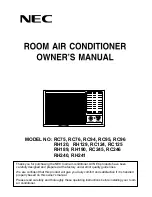
24
Split Compact Dedicated Outdoor
Air System Installation Manual
Due to our policy of continuous product innovation, some specifications may change without notification.
©LG Electronics U.S.A., Inc., Englewood Cliffs, NJ. All rights reserved. “LG” is a registered trademark of LG Corp.
REFRIGERANT PIPING SYSTEM INSTALLATION
Refrigerant Pipe Insulation
All refrigerant piping from the outdoor unit to the DOAS units must be insulated correctly for safety and usage. Y-branch connections, re-
frigerant piping, field-provided isolation ball valves (if present), service valves, and elbows must be properly and completely insulated using
closed cell pipe insulation (up to the DOAS piping connections). To prevent heat loss / heat gain through the refrigerant piping, all refrigerant
piping including liquid lines and vapor lines must be insulated separately. Ethylene Propylene Diene Methylene (EPDM) insulation must be a
minimum 1/2 inches thick, and thickness will need to be increased based on ambient conditions and local codes.
All insulation joints must be glued with no air gaps. Insulation material must fit snugly against the refrigeration pipe with no air space between
it and the pipe. Insulation passing through pipe hangers, inside conduit, and/or sleeves must not be compressed. All pipe insulation exposed
to the sun and outdoor elements must be properly protected with PVC, aluminum vapor barrier, or alternatively placed in a weather-resistant
enclosure such as a pipe rack with a top cover; and meet local codes. LG-provided Y-branches are shipped from the factory with pre-formed
peel-and-stick foam insulation jackets, with a 1.84 lb./ft3 density, 1/2 inch thickness, and meet UL94 MF-1 flammability.
The design engineer must perform calculations to determine if the factory-supplied insulation jackets are sufficient to meet local codes and
avoid sweating. Add additional insulation if necessary. Check the fit of the insulation jacket after the fitting and all run-out pipes are installed.
Mark all pipes at the point where the insulation jacket ends. Remove the jacket. Install field provided insulation on the run-out and main trunk
pipes first. Install the LG-provided insulation plugs on the ends of all unused header ports.
Insulation
•
Do not insulate gas and liquid pipes together as this can result in pipe leakage and malfunction due to extreme temperature fluctua-
tions.
• Always properly insulate the piping. Insufficient insulation will result in condensation, reduced heating/cooling performance, etc. Also, if the
pipes aren’t insulated properly, condensation could potentially cause damage to building finishes. Pay special attention to insulating the
pipes installed in the ceiling plenum.
• Fully insulate the piping connections.
• Follow local codes and the designer’s instructions when selecting ethylene propylene diene methylene (EPDM) insulation wall thickness.
















































